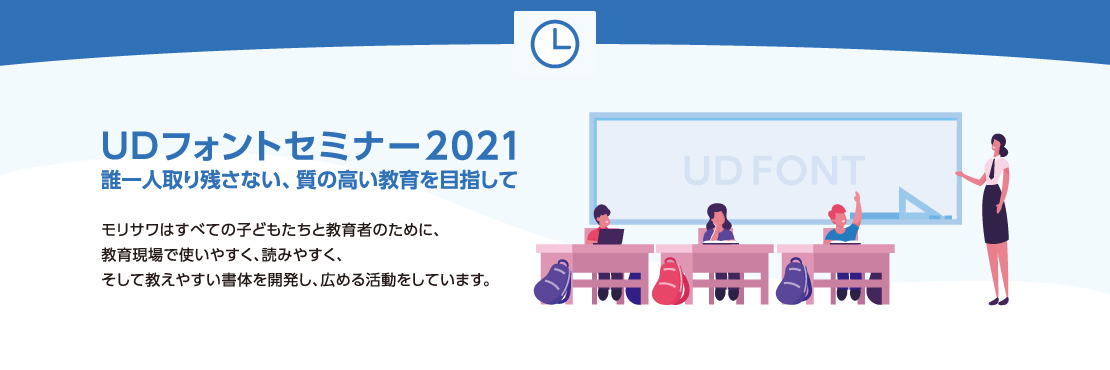
Morisawa held an online UD font seminar for three days from July to August 2021, inviting people who are actively using UD fonts in the educational field.
Under the theme of "Aiming for high-quality education that leaves no one behind," he spoke about the forefront of learning, including English education from elementary school to university, and Japanese language education for international students.
This is a report on Day 3. (Article by Morisawa's Ryosuke Nitano)
Day1(1),Day1(2),Day 3
Along with each seminar report, you can also watch archived videos from the day.
*Registration is required to watch videos.
UD fonts as part of an effort to introduce ICT into universities
On the third day of the seminar, two professors from universities that have already introduced the MORISAWA BIZ+ UD Font Plan took to the stage. Each professor spoke about the need for UD fonts, the reasons and circumstances that led to their introduction, how they are currently using UD fonts, and what activities they are involved in using UD fonts.
Speaker: Professor Kazuhisa Niwa, Deputy Director of the ICT Infrastructure Center, Nagasaki University
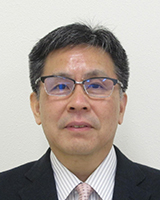
Professor Niwa talked about how he first learned about UD fonts and how they were introduced at his university. He also talked about the specific promotional activities that were carried out on campus at the time of and after their introduction, as well as advice for schools that are considering introducing them in the future.
Professor Niwa first encountered UD fonts when he heard about the concept of "universal design for character expression" from Morisawa at the exhibition booth at the AXIES annual conference in 2018. The following year, he became aware of the existence of students in his classes who needed special consideration, and began collecting information on UD font products.
In 2020, when the COVID-19 pandemic began, universities began online classes shortly after the start of the semester in early April. However, they noticed that students continued to stare at their materials, and in May the university began to seriously consider introducing "Universal Design Fonts."
First, they explained the importance of display characters to the Disability Student Support Office, the Diversity Promotion Center, the Vice President, the Executive Director in Charge of Student Affairs, and the Executive Director in Charge of Education, and after coordinating with the relevant departments, they secured a budget for the introduction of UD fonts on campus in August.
In fact, because it was not possible to immediately roll out the technology to the entire university, the UD fonts were introduced in September in limited departments, such as the Disability Student Support Office and the Diversity Promotion Center. At that time, Professor Niwa created a mailing list to support users and provided support such as preparing and distributing installation manuals.
In October, he began promoting the system within the university and began using it in his own courses. He also began considering using it in liberal arts courses in the information sciences for the following academic year, and in April 2021 he received a license from the University Education Innovation Center, the organization responsible for university-wide education.
Additionally, at the department's Faculty Development session, one of the aims of the lecture was to "raise awareness of accessibility in online classes," and UD fonts were introduced, along with examples, as one of the "measures to improve accessibility in online classes that can be implemented immediately" regardless of whether or not a student has a disability.
He also shared some key points for promoting the technology within the university.
The first is "developing collaborators." After checking the students' reactions by using UD fonts in the liberal arts courses he teaches, he collaborated with several instructors of information science courses to use UD fonts in their teaching materials. He is also working to explain the advantages of UD fonts to instructors of career courses and request their use.
Furthermore, "individual support for use" and "awareness of improved accessibility" are mentioned. (I highly recommend watching the video to learn more about this.)
In the second half of the presentation, he mentioned providing template files and specific setting samples for frequently used programs such as Word as a way to popularize UD fonts on campus. Furthermore, in light of the current situation where UD fonts are not installed on all PCs, he is considering a promotional measure that uses the UD fonts that come standard with Windows 10, but replaces them with high-quality UD fonts after content is finalized and embeds them.
Finally, as a topic, we received feedback and advice on how to use the newly released "Stroke Order Font."
It was an impressive talk about how, in the new initiative of online classes, it was being introduced from a student-first perspective as a universal design initiative.
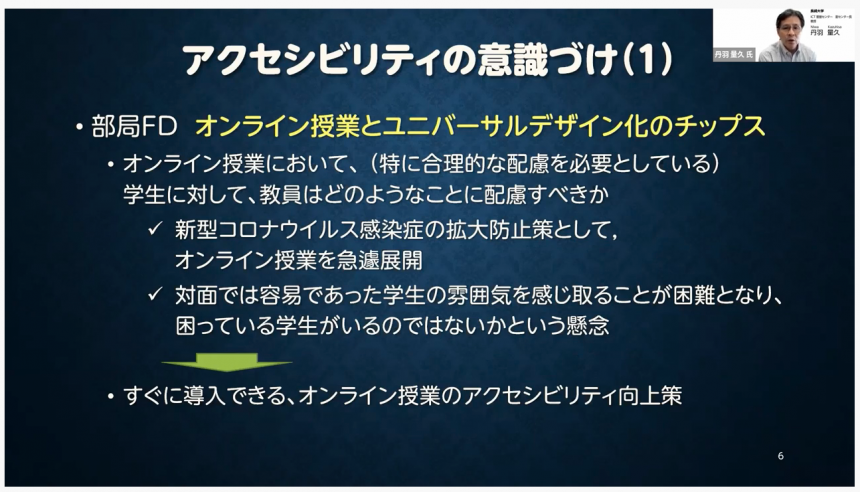
Speaker: Masaaki Ishii, Professor, Faculty of Global Liberal Arts, Kanda University of International Studies
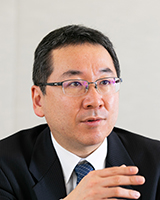
Professor Ishii talked about a variety of topics, including the changes in "ways of thinking and looking at things" that were triggered by the introduction of UD fonts in 2019, and collaborative classes on the theme of universal design.
Kanda University of International Studies is a language and international university with a campus in Makuhari, Chiba Prefecture. This year, a new Faculty of Global Liberal Arts was opened, and Professor Ishii is enrolled there.
Kanda University of International Studies, as part of the Sano Gakuen educational corporation, signed a contract to use UD fonts in September 2019. In today's society, where we are surrounded by a vast amount of diverse information, Kanda University of International Studies became the first private university to institutionally adopt UD fonts in order to promote "universal design of information" that is easy to understand for many people across the entire educational corporation. Currently, UD fonts are being used by faculty and staff in the Kanda area, where the headquarters and vocational school are located, and the Makuhari area, where the university is located.
Professor Ishii also spoke in detail about the background to the introduction of UD fonts in the Shikyoiku Shimbun (December 2019 issue (No. 83)), and the subheading of the article, "UD fonts made me realize my lack of imagination," was a key word related to this discussion.
Initially, they thought that by considering the font, they could make the text easy to read for a very limited number of students, but after introducing it, they realized that they could actually think from a broader perspective, making it easy to read and understand for everyone.
We were also given information about a survey conducted among faculty and staff at the university regarding their use of UD fonts, now in its second year since the fonts were introduced.
Regarding satisfaction with UD fonts, the majority of respondents answered "satisfied" or "fairly satisfied," and regarding frequency of use, the majority answered "frequently" or "fairly used." Furthermore, various actual testimonials were shared, including that UD fonts are ideal for creating English picture books, are used in Japanese language teaching materials for foreigners, are very popular with exchange students, allow some learners to study without stress, and administrative staff have made UD fonts their standard. The fact that UD fonts are being used from a wider variety of perspectives and standpoints than initially imagined is a very important point.
Furthermore, he mentioned that the introduction of UD fonts was a catalyst for the "Innovation KUIS Project," in which faculty, staff, and students worked together to conduct face-to-face, online, and hybrid classes during the COVID-19 pandemic, and that the various ideas and realizations gained from this were useful. He said that the introduction of UD fonts not only provided ease of reading, but also raised awareness of creating an appropriate learning environment in all situations, creating an environment that is easy for everyone to learn in, whether face-to-face or online.
In order to share these insights with students, an online poster creation class was held from June to July 2020 in collaboration with Morisawa, an industry-academia collaboration, on themes related to universal design, and feedback from students who took the class was also shared.
https://fontswitch.jp/post/5973
The students' opinions were also introduced through a class questionnaire. During the seminar, Professor Ishii repeatedly used the word "awareness" as a message. (Please check out the video.)
He also said that UD fonts are not just a tool, but that because they had experience of introducing them before COVID-19, they were able to take care of things even during the COVID-19 pandemic, and that this was the catalyst that led to "creating an appropriate learning environment" for students. This was very pleasing to hear.
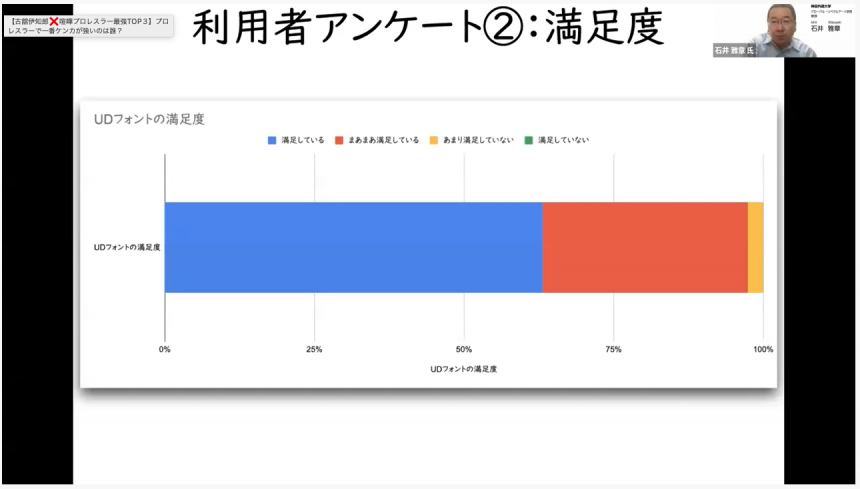
There was only a little time left at the end, so after both professors' talks, we asked them to answer any questions they had.
It's a very interesting video, so be sure to check it out.

